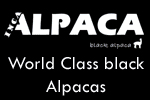Articles by Alpaca World Magazine:
A SOUND FOUNDATION.
Nick Harrington Smith
A SOUND FOUNDATION.
International judge Nick Harrington Smith of the The Alpaca Stud, takes us through the basics of alpaca conformation.
Another year in the alpaca business almost over, more shows than ever, and with more owners than ever taking part in those shows, suggests that showing is becoming an ever increasingly important part of breeder?s decision-making process. Whilst no doubt show results are a useful tool, I have been quizzed as to why the show ring seemingly ignores conformation. Such comments from a number of sources caused me to think about conformation in general. I don?t agree that the judges ignore conformation but it is possibly not reasoned as emphatically as fibre traits, perhaps because of the 60:40 weighting. I will defend the judging fraternity in this respect and remind all that with only a few minutes per alpaca available, there is simply not the opportunity for any judge to describe in detail, and in a matter of seconds, all of the individual alpacas traits, be they good or bad. Reasons or excuses aside, this issue alone re-enforces the argument that breeders should not use show results to make breeding decisions, but more importantly the need to be proactive in understanding why conformational points are individually so important. We see much written about individual fibre traits, but rarely about conformation so it is perhaps useful to refresh in our minds those basic traits that are most important. I was reminded recently that we all tend to forget the basics as we try to keep up with the latest news and developments in the alpaca world.
The definition of conformation as per the Oxford dictionary reads ?The shape or structure of something, especially an animal, Collins also includes ?the arrangement or parts of an object? so within our alpacas we can see the general shape immediately but we also need to appreciate how the parts or skeleton is configured to appreciate how deviation from the normal may impact on the well-being of the animal. After all, we need to ensure the most basic need, that is for the alpaca to be functional, or fit for purpose.
So, back to basics with a simple reminder of those basic conformational traits we need to be constantly aware of.
PHENOTYPE:
Whilst often used as a general description of the overall appearance or shape of the alpaca, this is a collective term of all external traits more often used to infer that the alpaca matches the picture in one?s head of a true alpaca type.
WHY IS THIS IMPORTANT:
This is an important judgement of first impressions, if that first impression is that there are Llama traits apparent it is not unusual to find fibre traits in the animal that are undesirable in alpacas. This may be such things as Roman nose, banana ears, high tail set and most importantly significant numbers of very coarse primary fibres, most often these are true guard hairs (Medullated fibres).
HEAD TYPE:
A triangular head with good depth to the lower jaw line below the eyes and good breadth of muzzle are indicative of the true alpaca type. Ear shape is also important with a triangular ear shape being indicative of a true to type alpaca. It is worth noting that with both head and ear shape there is considerable scope for variations and still be considered acceptable.
PROPORTIONS:
Proportions or balance is easily seen by the vast majority of people, the challenge is often to work out where any imbalance is. With alpacas, we are looking for neck and leg lengths that are similar, with the neck length being two-thirds the length of the back. Perhaps one of the most common faults we see is that of an alpaca with a long back.
WHY IS THIS IMPORTANT:
Such imbalanced animals suffer from extra stresses and strains on a back line that is overly extended. In the case of a shortened back line, there is an obvious reduction in internal capacity, in turn affecting the ability to maintain body condition and or pregnancy.
TOP LINE ? perhaps the easiest of the more common faults to spot is a weak backline, this can be either a humped back, less common, which can also be linked with sickle hock (see below), or a dipped or concave back, an impression that can be created by a dip in the fleece, or a dip in in the spine, so must be checked by running your hand along the top line to check for deviation. A dip in the back line is not uncommon in older females that have produced a number of cria. Bearing this in mind the severity of the condition should be gauged against each individual animal.
WHY IS THIS IMPORTANT:
Any weakness in the back line can lead to undue wear and tear so should be considered as a significant fault although individual circumstances should be taken into consideration.
BODY CAPACITY:
This can be split into three separate areas.
? Capacity through the chest. A wide chested alpaca will have room for the lungs and heart to develop and work properly giving rise to potentially greater lung and heart capacity, and thus greater stamina.
? Body Capacity. With good depth and breadth within the rib cage and main body (often described as a good spring of rib) allows for greater stomach capacity and therefore greater intake and digestion of food and nutrients. Allowing for better maintenance of body condition. Also important in females allowing for more room for the pregnancy to develop.
? Capacity through the hindquarters, particularly important for reproduction. In the male this gives rise to better muscular development, and therefore the ability to better perform when breeding females.
LEGS:
These should be straight when viewed from the front or back. It is not abnormal to see some minor deviation at the knee on the front legs when viewed from the front. With regard to the rear legs, again there can be some minor deviation although this is viewed as being more important than similar deviation in the front legs.
Side View:
The front legs should be straight. Deviation from this perspective is more usually seen at the knee, either forwards or backwards and should be considered as a more serious defect.
The rear legs should show some angulation at the hock with an internal angle of circa 140 degrees. If the leg is straighter from the hock down than this, it is called post legged. Often the first indicator of this is when the animal stands taller in the hindquarters than at the withers. If the angle is greater it is called sickle hocked and a good indicator of this is when the alpaca is hump backed or tucked under at the tail. Sickle hocked is the more serious of these two hind limb defects although the more rarely seen.
Pasterns ? Soft or dropped pasterns (weak fetlocks) are not that uncommon and can be caused by congenital weakness or physical injury. When either front or back legs are viewed from the side the first joint above the foot can be seen as touching the ground or the joint is showing some sponginess. Any weakness in this area should be considered a major defect.
Luxating Patella ? This weakness cannot be definitively diagnosed visually, and requires palpation of the patella for confirmation. It should be remembered that the kneecap will move slightly and overzealous palpation can create the defect. The first indication of a problem is when watching the animal walk with some apparent ?wobble? being evident in the gaskin (upper leg) region.
WHY IS THIS IMPORTANT:
Correct leg set or angulation of the limbs allows for proper and fluid movement, but above all else if the joint angles are wrong it will create more pressure on the joint creating weakness and or excessive wear. This in turn creates pain and discomfort leading to lack of mobility and an inability to function. Ultimately, it is highly likely such conditions lead to a shortened life.
BITE:
Whilst hugely important, this is an area of conformation that causes most confusion. We should see in an ideal bite the teeth meeting the upper dental pad up to ¼ inch behind the front of that top pad. Given that in animals as in humans the angle that teeth erupt from the gum line varies, it is more important that the gum alignment be correct. The lower gum should be at least ¼ inch back from the front of the top dental pad but no more than ½ inch back. If the gum alignment is good it is more practicable to accept that, a bite whilst perfect on a youngster, may change as the teeth change. If in doubt, it is worth checking that the molars actually line up, if they don?t this is a serious fault.
WHY IS THIS IMPORTANT:
If the bite is bad, an animal will need more intervention to ensure that it is properly able to feed. This clearly creates a greater workload but if not properly managed will impact on the longevity of life and or ability to raise cria effectively.
Males with a bad bite should be viewed with great suspicion, more especially if being considered as potential Herdsires.
The above is a very simplistic rundown on the various traits which will need to evaluate within your own herd. There are however, some conformational traits that should lead to disqualification from the show ring and or any breeding programme. They are:
? Wry Face.
? Kinked Tail.
? No Tail.
? Polydactylism ? more than 2 toes on any foot
? Syndactylism ? Fused toes.
? Fused Ears.
? Gopher ears (Short Ears).
? Ectopic Testicles.
? Incomplete, improperly formed or incorrectly proportioned genitalia
Having read the horror story above it is important that you equip yourself as best you can to make your own assessment of conformation. Look up any words you don?t understand, look at diagrams of an alpaca, learn to associate body parts with various movements within the skeletal frame, and learn to trust your instinct, but above all else please remember the following advice:
It is vital when making a visual assessment of conformation that one maintains a proper perspective. Alpacas as in humans are rarely found in perfect form, so any faults are best described as ?minor?, ?moderate? or ?major?. Once we recognise and properly identify those faults, we can begin working on correcting those faults by selective breeding.
If this all seems a little basic I apologise, but even in the writing of this piece it has reminded me that we all need to remember the basics, otherwise we cannot hope to build a sound foundation.
Tweet



